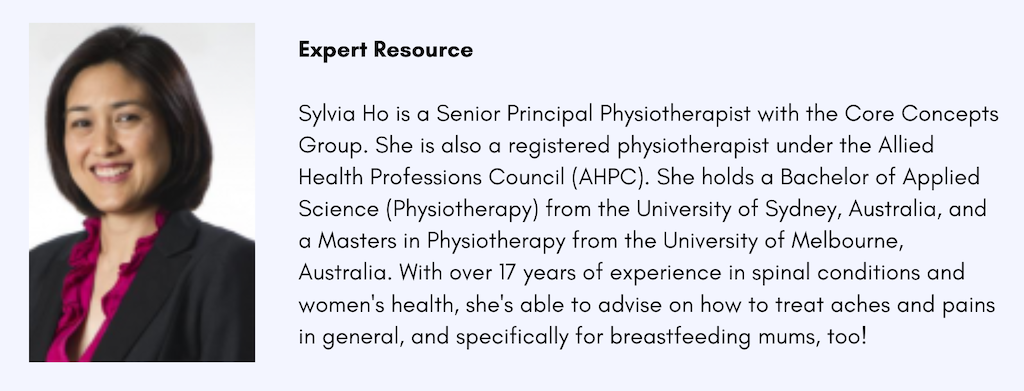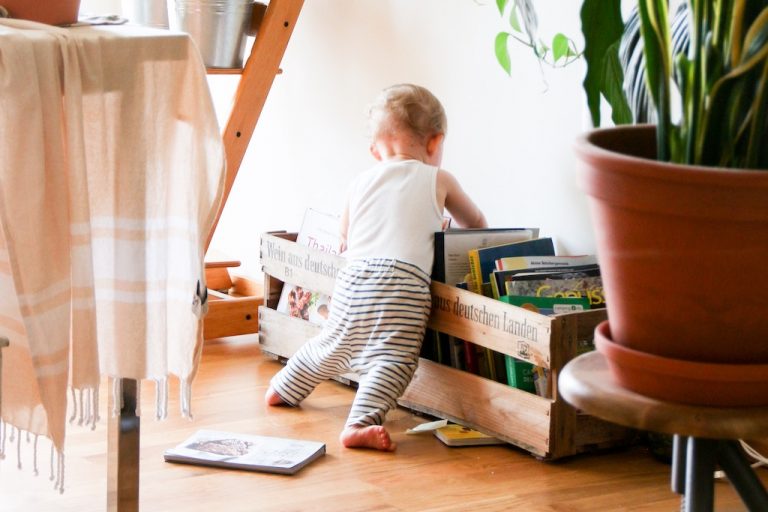SingaporeMotherhood | Baby & Toddler
September 2018
Breastfeeding Hacks: Ease those Aches and Pains from Nursing your Newborn

Breastfeeding is one of the most significant ways a mother and her newborn bond. You’d think it would be easier, being supposedly au naturel, but it consistently proves to be a challenge for some mums. Apart from the more talked-about problems like poor latching, low milk supply, and clogged ducts, there is a host of other issues that can plague breastfeeding mums — aches and pains.
If you’ve experienced back aches or a sore neck from breastfeeding, you’ll know what we’re talking about. It puts a strain on Mum’s already fatigued body, and can even put a damper on the bonding experience. However, this doesn’t have to mean the end of your breastfeeding journey. Sylvia Ho, Senior Principal Physiotherapist of Core Concepts Group, sheds some light on how to breastfeeding without the backaches.
What are some of the common aches and pains that breastfeeding mums face?
A common experience for many new mums is that of pain — not just nipple pain, but aches and strains in the neck, back, and shoulder. This can stem from poor posture adopted during feeding, and it makes sitting still while breastfeeding a big challenge.
Another difficulty mums tend to face is thumb and wrist pain. This is called the De Quervain syndrome. De Quervian syndrome is not necessarily caused by breastfeeding per se, but rather an overuse of a particular muscle at the back of the thumb, near the wrist. This tends to occur with repeated supporting of Baby’s floppy head in the early months or from repeatedly picking up Baby.
What are common postural errors during nursing?
Most mums breastfeed in the cradle hold, seated down, with their backs unsupported. They hold up the weight of Baby, which places a strain on both their upper and lower back. Nursing mums often gaze down lovingly at Baby too. However, in doing so, they round their upper back, and lower their necks, putting more strain on these areas.
The advent of mobile technology also means that many mums scroll through their mobile phones while breastfeeding. This causes them to add strain on their necks, which are in a lowered position. These postures can tax the muscles and spine when maintained over long periods of time, eventually causing aches and pains.
How can breastfeeding mums correct these postures?
These erroneous postures can be corrected by tackling two key problems. First, nursing mums should adopt the right posture to ensure that their upper body is upright and open, rather than curved and hunched over. Secondly, they should find the right support so that they will not develop excessive strain from carrying the weight of the baby.
Which postures can help alleviate breastfeeding posture aches and pains?
The two recommended postures for breastfeeding are the cradle hold (done correctly), and the side-lying position.
Cradle Hold Position
With the cradle hold, you should sit all the way into the chair, ie. bums at the back of the seat. This ensures that your back is well-supported. Baby should also be elevated using a nursing pillow or cushion on your lap. This reduces the need for you to hunch forward. Next, bring Baby up to the nipple and prop them up using the pillow/cushion for support. As much as possible, you should not feel as if you are carrying the weight of the baby in their arms; rather, it is about guiding the baby into the right position to latch.
Side-Lying Position
Side-lying is a position that works particularly well, especially when mums are tired. In this position, your head should be fully supported with a pillow. Both your neck and spine should be neutral – not rounded backwards or forwards — with a pillow between the knees.
When feeding in the side-lying position, Baby is tucked close to you and also lying on the side, with the nose in line with your nipple. To support Baby, you can also consider using a pillow, placed close to the baby’s bottom and lower back. Again, do not hunch forward and direct your breast to the baby. Rather, use the upper arm to guide your breast as Baby opens their mouth to attach. Finally, when in this position, take note to periodically change the side you are lying on.
What can a breastfeeding mum do to make her nursing experience easier?
The solution may sound simple but it bears repeating – always remember to get adequate rest! Beyond that, here are a few tips you can implement to make the experience more comfortable.
1. Look for a comfortable place to breastfeed. Try checking if your regular breastfeeding spot is set up right before you start your routine. You should be using a chair that supports your back; it should also allow your feet to reach the ground. Experiment with using a pillow to support you or Bub.
2. Bring the baby to the breast. As a general rule of thumb, never bend towards the baby, as this will strain your neck and back.
3. Stay mobile. Switch between different positions, as staying still for long periods of time can strain your muscles and spine. In between feedings, be sure to stretch your neck and back often, too!
4. Manage your time. To save time and have more rest, some Mums have suggested expressing milk while feeding the baby on the other breast.
Are there any posture-benefitting exercises nursing mums can do?
Doorway Stretch
This stretch can be done in a corner of a room or at a doorway. Hold on to a doorframe, keeping your wrists, elbows, and shoulders in line. Keeping your arms in place, slowly lunge one leg out in front of you towards the wall or past the doorframe. Move as far as you can without straining and hold the pose. Ensure that your neck remains aligned with your spine. For more of a stretch, lean your body out over your front leg. Repeat with the other leg.
Neck Stretch
Gently bring your right ear toward the right shoulder, feeling the stretch along the left side of the neck. Stop and hold for 15 to 30 seconds. Relax the head back to neutral and repeat again. Then stretch the other side by bringing your left ear toward your left shoulder. Repeat two to three times for each side.
For a more intense stretch, you can gently weigh your head down with the opposite hand, or hold your hand behind your back to keep the shoulder down while stretching the neck.
Side-Lying Thoracic Spine Stretch
Lie on one side with your arm tucked under your head for support, hips stacked on top of each other, and knees tucked up to hip level. Reach out your top arm straight in front. Keeping your knees and hips still, slowly reach the top arm up and behind you until you reach a stopping point. You should feel a stretch through the torso. Your hips may want to fall backwards as you twist – be sure to keep them stationary! Hold at your furthest point of stretch and slowly return to the start. Repeat on the other side.
Finally, what’s your #1 go-to as a breastfeeding hack?
A comfortable state of body and mind adds positively to the breastfeeding experience – which is why it is so important for nursing mums to keep their muscles loose, stretched, and at ease!
Breastfeeding may be tough, but it’s also one of the most intimate experiences you can share with your child. Don’t give up Mum, you’re on your way to a better breastfeeding experience!

Header image: Source
Featured image: Source
All content from this article, including images, cannot be reproduced without credits or written permission from SingaporeMotherhood.
Follow us on Facebook, Instagram, and Telegram for the latest article and promotion updates.













